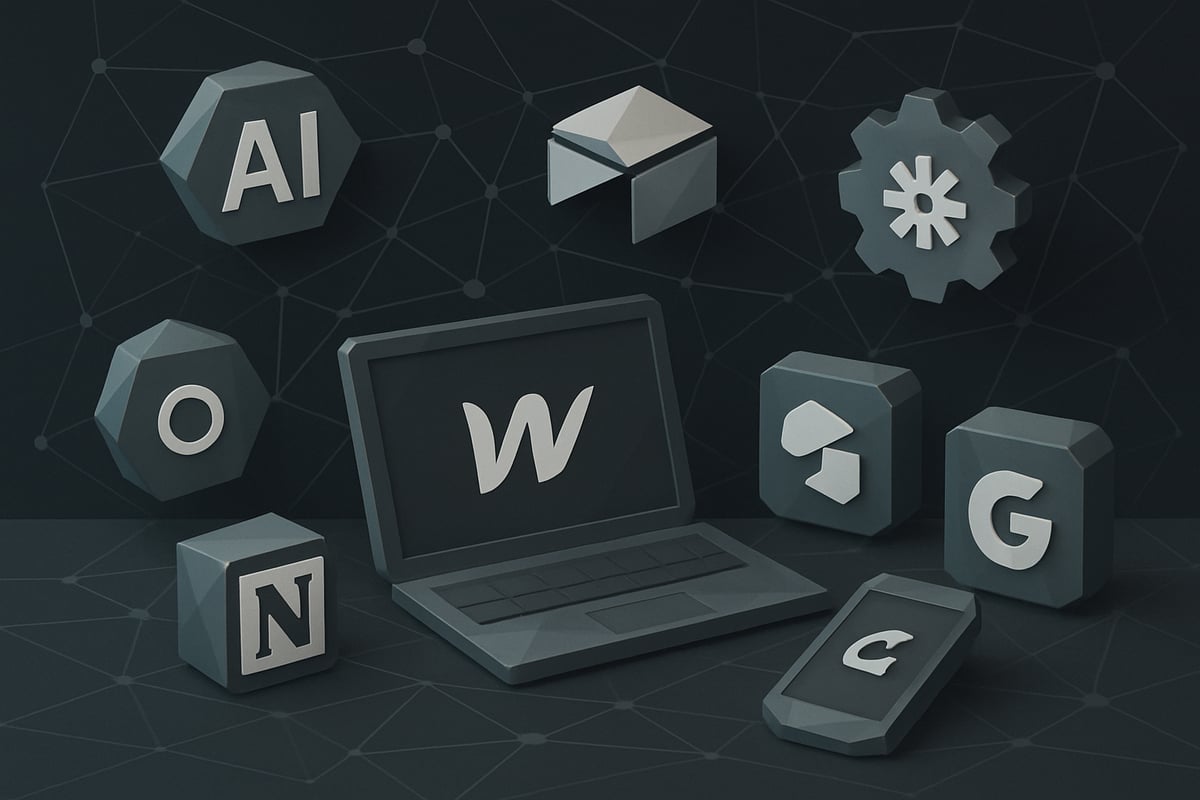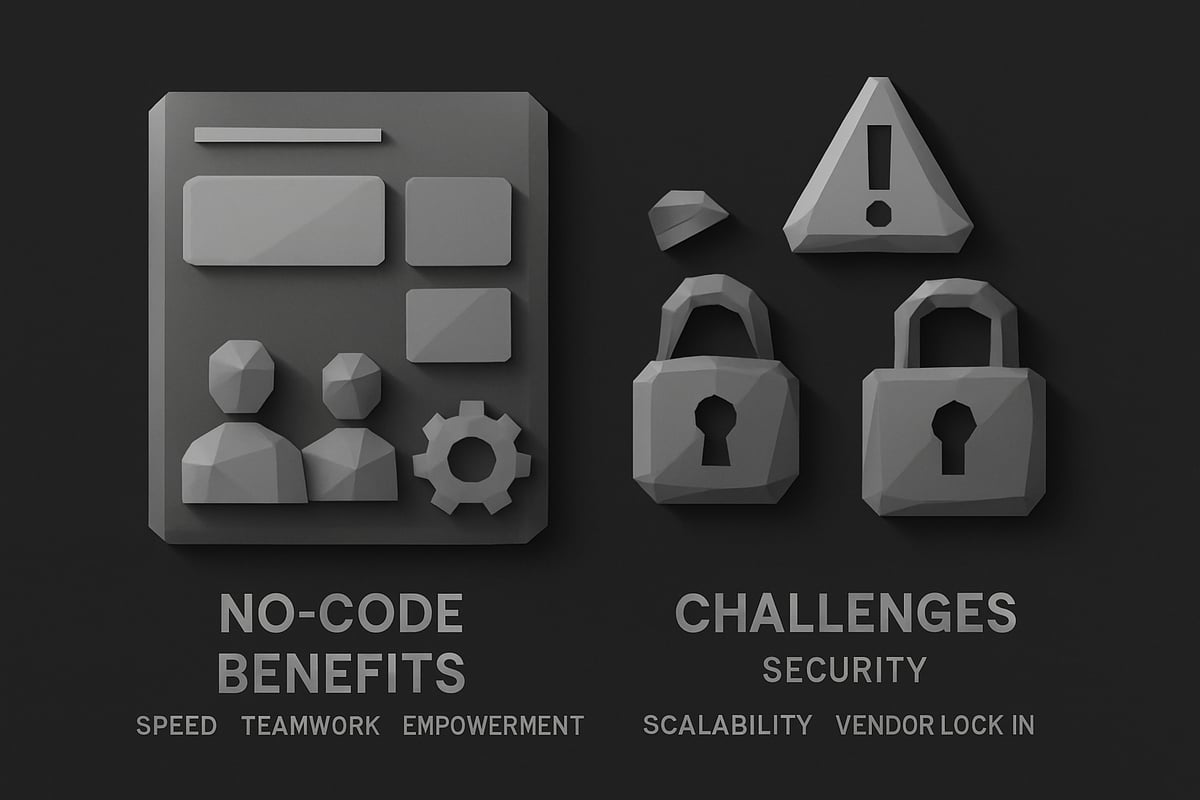Imagine a world in 2025 where anyone can build powerful apps, automate workflows, and launch digital solutions—all without writing a single line of code. The rise of visual development has put innovation within reach for everyone, not just expert programmers.
In this guide, we break down the no-code movement, showing you exactly how no code no problem is more than a slogan—it is a strategy for unlocking your business’s digital future. You will discover the fundamentals of no-code, explore its 2025 landscape, evaluate top platforms, and see how real businesses are creating value faster and smarter.
Ready to accelerate your digital transformation and innovate with confidence? Dive in to learn how no-code can empower you to turn ideas into scalable solutions.
Understanding No-Code: What It Is and Why It Matters in 2025
Imagine solving modern business challenges with a toolset designed for accessibility, speed, and innovation. At its core, no-code refers to platforms that allow users to build apps, automate workflows, and create digital products without any traditional programming. In contrast, low-code platforms offer similar visual builders but supplement them with optional coding for advanced customization. This distinction is crucial to the no code no problem philosophy, which focuses on empowering everyone to create.
To better understand, consider the evolution of digital creation. In the early days, building a website or app required deep technical skills and manual code. Today, drag-and-drop builders, visual workflow designers, and automation tools have redefined what it means to create. The no code no problem approach removes the barrier of code, letting non-technical users innovate, launch products, and automate processes with ease.
A significant shift is underway in business logic and strategy. Companies no longer solely urge teams to “learn to code.” Instead, organizations embrace the mindset of “build without code.” This transition is driven by the urgent need for speed, flexibility, and efficiency in digital transformation. According to Gartner's 2025 No-Code Adoption Forecast, 70% of new business applications will be built using no-code or low-code platforms by 2025. This statistic underscores the scale and momentum of the no code no problem movement.
The impact stretches across the business spectrum. Startups leverage no-code to prototype quickly and validate ideas with minimal resources. SMBs use these tools to automate repetitive tasks, streamline operations, and stay competitive. Enterprises deploy no-code for rapid prototyping, internal tools, and bridging the gap between IT and business teams.
Consider real-world examples that bring these changes to life. Entrepreneurs like Dani Bell, founder of Scribly.io, built scalable businesses using no-code tools. Companies utilize platforms such as Webflow for design, Airtable for databases, and Zapier for automation. These stories highlight how the no code no problem mindset breaks down traditional barriers, fosters inclusion, and challenges the stereotype that only expert coders can innovate in tech.
The cultural impact is profound. No-code not only democratizes creation but also encourages a more diverse group of innovators. By lowering technical barriers, it enables more voices to participate in building the digital future. As we move into 2025, the no code no problem approach will continue to reshape how we think about problem-solving, business growth, and digital transformation.
| Feature | No-Code Platforms | Low-Code Platforms |
|---|---|---|
| Coding Required | None | Minimal (optional) |
| Target Users | Non-technical | Technical & non-technical |
| Customization | Limited | Advanced possible |
| Speed to Launch | Fast | Fast, with flexibility |
| Typical Use Cases | MVPs, automations | Complex apps, integrations |

The No-Code Landscape in 2025: Top Platforms & Emerging Trends
The no code no problem movement has transformed digital creation, making it accessible to everyone in 2025. Today, businesses and individuals are adopting no-code platforms at a record pace, driven by the promise of speed, flexibility, and innovation.

Top No-Code Platforms in 2025
The no code no problem era is defined by a vibrant ecosystem of platforms, each catering to different use cases. Here’s a quick comparison of the top players:
| Platform | Core Strengths | Best For | Notable Features |
|---|---|---|---|
| Webflow | Visual web design | Marketing, landing pages | CMS, animation, SEO |
| Bubble | App logic, workflows | SaaS, marketplaces | Data modeling, plugins |
| Airtable | Database, automation | Operations, tracking | Relational databases |
| Zapier | Integrations, automation | Workflow automation | 5,000+ app connections |
| Notion | Docs, project mgmt | Internal tools, wikis | Custom templates, API |
| Glide | Mobile-first apps | Simple mobile solutions | Spreadsheet-driven apps |
These platforms are at the heart of the no code no problem philosophy, letting users build and launch digital products with unprecedented ease.
Innovations: AI and Automation at the Core
In 2025, AI-powered no-code tools are rapidly gaining ground. Builders now leverage generative AI to design interfaces, suggest logic, and automate repetitive tasks. Platforms like Webflow and Bubble have integrated AI assistants, making it easier for users to go from idea to prototype in minutes.
Automation-first platforms are also emerging, streamlining complex workflows with minimal setup. With no code no problem, creators can connect APIs, trigger actions, and scale their operations without traditional programming.
Industry-Specific Solutions and Market Growth
The no code no problem trend is not limited to general app development. Industry-tailored platforms are thriving, addressing needs in e-commerce, SaaS, marketing, and internal business tools. For example, e-commerce entrepreneurs use Shopify’s no-code extensions, while marketers automate campaigns with tools like Notion and Zapier.
Business adoption is surging, with Forrester's Insights on No-Code Platforms revealing that 84% of companies are turning to no-code and low-code to address developer shortages. The user base continues to expand, fueled by demand for agile, cost-effective solutions.
Mobile-First and Cross-Platform Development
Mobile-first thinking is central in the no code no problem landscape. Platforms like Glide and Adalo enable users to build mobile apps directly from spreadsheets or visual builders. Cross-platform deployment is now standard, allowing digital products to launch seamlessly on web and mobile.
Short development cycles and accessibility mean that even small teams can compete with larger organizations, driving innovation across industries.
Open-Source vs. Proprietary Platforms
Users in the no code no problem space often choose between open-source and proprietary platforms. Open-source tools offer transparency, customization, and community-driven support. Proprietary platforms, on the other hand, provide robust security, dedicated support, and a smoother onboarding experience.
Here’s a quick summary:
- Open-source: Greater flexibility, no vendor lock-in, community-driven updates
- Proprietary: Streamlined UX, integrated support, advanced security features
Selecting the right approach depends on project needs, compliance requirements, and long-term goals.
Enterprise Adoption and Future Outlook
Enterprises have embraced the no code no problem movement for rapid prototyping and internal tool development. Large organizations use platforms like Airtable and Bubble to empower non-technical teams, bridge gaps between business and IT, and accelerate digital transformation.
Looking ahead, the no-code landscape will continue to evolve. Expect deeper AI integration, more industry-specific solutions, and increased focus on interoperability and security. No code no problem is more than a trend—it is reshaping how digital solutions are built and delivered.
Step-by-Step Guide: How to Unlock Digital Solutions with No-Code
Unlocking digital solutions in 2025 is more accessible than ever. The no code no problem philosophy empowers anyone to transform ideas into working products without traditional programming. Whether you are a business owner, entrepreneur, or problem-solver, following a structured process ensures you maximize the potential of no-code tools.

Step 1: Identify Your Digital Challenge
Begin by defining the problem you want to solve. Are you trying to streamline a business process, automate repetitive tasks, or create a new customer-facing app? Clearly stating your challenge is the first step in the no code no problem journey.
Ask yourself:
- What is the main pain point?
- Who will use the solution?
- What outcome do you expect?
By focusing on a specific challenge, you avoid unnecessary complexity and set a strong foundation for your project.
Step 2: Map Out the Workflow
Once you have identified the challenge, sketch out the desired workflow or user journey. Visualize each step from start to finish. Use flowcharts or diagrams to map how users interact, what data is needed, and which actions should be automated.
Tips:
- Break the process into logical steps
- Identify manual tasks that could be automated
- List the key data inputs and outputs
This clarity ensures your no code no problem solution will be both efficient and user-friendly.
Step 3: Choose the Right No-Code Platform
Select a platform that matches your project's scope and requirements. There are specialized tools for websites, mobile apps, automation, and databases. Popular choices in 2025 include Webflow for web design, Glide for mobile, Airtable for databases, and Zapier for automation.
Consider:
- What type of solution are you building?
- Does the platform support necessary integrations?
- Are there templates or components to speed up development?
Choosing wisely here makes the rest of the no code no problem process smoother.
Step 4: Build Interfaces and Logic Visually
Leverage drag-and-drop builders to create user interfaces, forms, and workflows. Most platforms offer visual editors, pre-built templates, and reusable components. Define logic with simple rules or flowcharts instead of code.
Checklist:
- Design clean, intuitive interfaces
- Use visual logic to automate actions
- Test each component as you build
This step brings your no code no problem concept to life without technical hurdles.
Step 5: Integrate and Automate
Connect your app to other tools and automate repetitive tasks. Tools like Zapier or built-in platform integrations allow you to trigger actions, move data, and send notifications.
Integration tips:
- Use APIs or native connectors for data flow
- Set up automation for reminders, emails, or updates
- Test integrations to ensure reliability
Automation is where the no code no problem approach delivers real efficiency gains.
Step 6: Test and Iterate
Gather feedback from users and test every feature. Iteration is key to refining your solution and addressing any issues early.
Steps:
- Conduct user testing sessions
- Collect feedback and prioritize improvements
- Update workflows and interfaces as needed
Continuous improvement ensures your no code no problem project meets real-world needs.
Step 7: Deploy and Monitor
When your solution is ready, deploy it to your intended audience. Monitor performance, track usage, and respond to user needs.
Deployment checklist:
- Go live on the right platform (web, mobile, internal)
- Set up analytics for tracking
- Plan for ongoing support and updates
With no code no problem, launching and managing digital solutions becomes a repeatable, scalable process.
Example: Building a Client Management Tool
Consider a small business owner needing a simple client management system. With the no code no problem mindset:
- Step 1: Identify the challenge: Tracking client interactions and follow-ups.
- Step 2: Map the workflow: New client onboarding, appointment scheduling, automated reminders.
- Step 3: Choose platforms: Webflow for the interface, Airtable for storing client data, Zapier for automation.
- Step 4: Build forms and dashboards in Webflow.
- Step 5: Connect Webflow forms to Airtable, set up Zapier to send reminders and notifications.
- Step 6: Test with a few clients, gather feedback, and refine the process.
- Step 7: Deploy for all staff and monitor usage.
This example illustrates how no code no problem enables rapid, cost-effective digital transformation for real-world needs.
Common Pitfalls and How to Avoid Them
While no code no problem solutions are powerful, be mindful of these challenges:
- Scalability: Not all platforms handle high traffic or complex logic well.
- Vendor lock-in: Relying on a single provider can limit future flexibility.
- Security: Ensure compliance with data privacy standards.
Mitigate risks by:
- Choosing platforms with open APIs
- Backing up data regularly
- Reviewing platform limitations before scaling
For an in-depth look at practical strategies, workflows, and tips, explore the Building Digital Products Guide.
Resources and Community Support
A thriving no-code community is ready to help. Join forums, attend webinars, and explore platform-specific resources. Learning from others accelerates your no code no problem journey and helps you stay ahead of trends.
Benefits and Challenges of No-Code Solutions
The rise of no code no problem platforms is transforming how organizations approach digital innovation. By removing technical barriers, these tools allow more people to build, automate, and launch solutions with unprecedented speed.

Key Benefits
No code no problem solutions offer a range of advantages for businesses and creators:
- Speed: Rapid prototyping and deployment, reducing project timelines from months to days or even hours.
- Cost-effectiveness: Save significantly by minimizing reliance on expensive development teams.
- Empowerment: Enable non-technical staff to solve problems and drive innovation without coding skills.
- Collaboration: Bridge gaps between technical and business teams, improving alignment and communication.
- Innovation: Foster a culture of experimentation, enabling more frequent iteration and testing.
With these strengths, no code no problem platforms make digital transformation accessible for startups, SMBs, and enterprises alike.
Core Challenges
Despite the benefits, no code no problem platforms present important limitations that organizations must consider:
- Scalability: Handling complex or high-traffic applications can be difficult, especially as usage grows.
- Vendor lock-in: Relying on a single provider may limit flexibility and future migration options.
- Security and compliance: Meeting industry standards requires careful evaluation of platform capabilities.
- Customization: Some advanced features or integrations may be out of reach compared to traditional coding.
Understanding these challenges is essential before fully embracing the no code no problem approach for mission-critical workflows.
Benefits vs. Challenges at a Glance
| Benefit | Challenge |
|---|---|
| Speed | Scalability |
| Cost savings | Vendor lock-in |
| Empowerment | Security |
| Collaboration | Compliance |
| Innovation | Customization |
This table highlights how no code no problem solutions can drive growth, while also presenting hurdles to navigate.
Adoption Statistics and Real-World Examples
Adoption of no code no problem tools is accelerating. According to IDC's Projection on No-Code App Development, over 500 million apps will be created using no-code platforms by 2024, showing the scale and reach of this movement. Yet, industry research finds that 30% of business users express concerns about platform flexibility and long-term fit.
In practice, many companies have achieved remarkable results. For example, startups have rapidly launched MVPs and automated back-office tasks without hiring developers. Still, other organizations have encountered challenges when their needs outgrew platform capabilities or compliance requirements became stricter.
Recommendations for Success
To maximize the benefits and minimize the downsides of no code no problem adoption:
- Start with clear requirements and identify workflows that fit no-code strengths.
- Combine no-code with open APIs or traditional coding for flexibility and scalability.
- Review platform security/compliance features regularly to ensure alignment with business needs.
- Engage with the no-code community to share lessons, access support, and stay updated on best practices.
For inspiration and practical guidance, explore these No-Code Startup Success Stories to see how others have navigated both the opportunities and limits of no code no problem platforms.
By taking a balanced approach, organizations can harness the power of no code no problem while preparing for future challenges and growth.
The Future of No-Code: Trends, Predictions, and What’s Next
The future of digital innovation is being reimagined by the no code no problem mindset. As we look toward 2025 and beyond, the landscape is rapidly evolving, driven by advancements in AI, automation, and an ever-expanding range of use cases. No-code is no longer just an alternative for non-technical creators, but a catalyst for industry-wide transformation.
AI and Automation: The Next Frontier
AI integration is reshaping what the no code no problem movement means for creators and businesses. Modern platforms now offer natural language app builders, letting users describe what they want in plain English. Predictive automation, powered by machine learning, anticipates user needs and recommends workflows.
Generative AI is not just a trend, but a foundation for future no-code tools. Imagine building an app by simply stating your requirements—no technical jargon, no syntax errors. This shift is making digital creation accessible for everyone, regardless of background.
Expanding Horizons: New Use Cases and Industries
No code no problem is fueling expansion into new domains like IoT, advanced data analytics, and enterprise-grade applications. Businesses are leveraging no-code to automate complex processes, connect smart devices, and visualize large datasets.
Industries such as healthcare, logistics, and education are adopting no-code for rapid prototyping and innovation. Cross-platform development is now standard, letting teams build solutions for web, mobile, and even wearable devices without writing code. This democratization means more voices can contribute to solving real-world problems.
Security, Compliance, and the Enterprise Shift
As adoption grows, so do concerns around security and compliance. The no code no problem approach is evolving to address enterprise needs, with platforms prioritizing data protection, user authentication, and regulatory compliance.
Open-source no-code tools are gaining ground, offering transparency and flexibility. Enterprises are blending no-code with traditional IT infrastructure, using APIs and hybrid models for better scalability. Collaboration between business and IT teams is becoming the norm, breaking down silos and accelerating digital transformation.
A table summarizing key enterprise considerations:
| Focus Area | No-Code Response |
|---|---|
| Security | Built-in encryption, access controls |
| Compliance | GDPR/CCPA modules, audit trails |
| Scalability | API integrations, modular design |
| Customization | Low-code extensions |
Market Growth, Community, and Challenges Ahead
The no code no problem movement is driving unprecedented market growth. According to Mordor Intelligence's Low-Code Market Forecast, the global low-code and no-code sector could reach $187 billion by 2030, reflecting massive investment and adoption.
Community-driven innovation is accelerating, with open-source projects and collaborative templates empowering users to share solutions. However, challenges remain. Regulation, platform consolidation, and evolving user expectations will shape the next wave of change.
Education is also evolving. Upskilling non-technical teams is now a priority, and no-code is central to digital transformation strategies for 2025–2030. As the ecosystem matures, the no code no problem philosophy will continue to lower barriers, making digital creation more inclusive and dynamic than ever.
As you’ve discovered, the no code movement is transforming how we approach digital solutions—making it possible for anyone to innovate, automate, and build impactful products without needing to code. If you’re ready to take your next step and turn your ideas into a thriving digital business, you don’t have to navigate this journey alone. At CreateSell, you’ll find the guidance, resources, and expert insights you need to confidently launch, grow, and automate your own digital products. Ready to unlock your potential and start building for 2025 and beyond?
Get Started